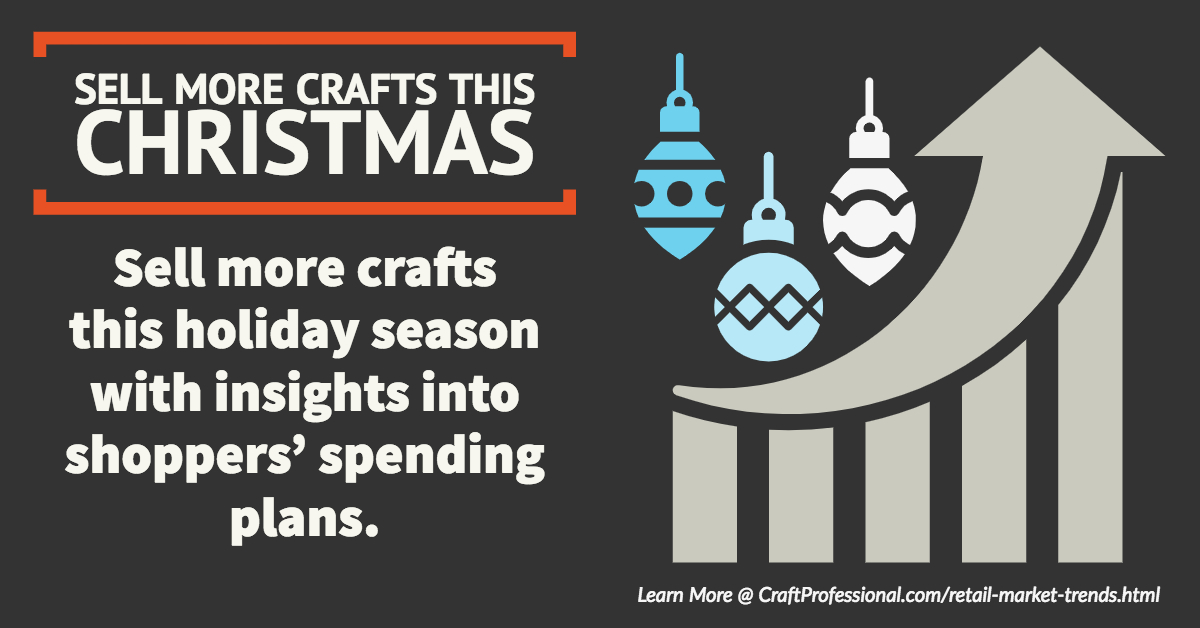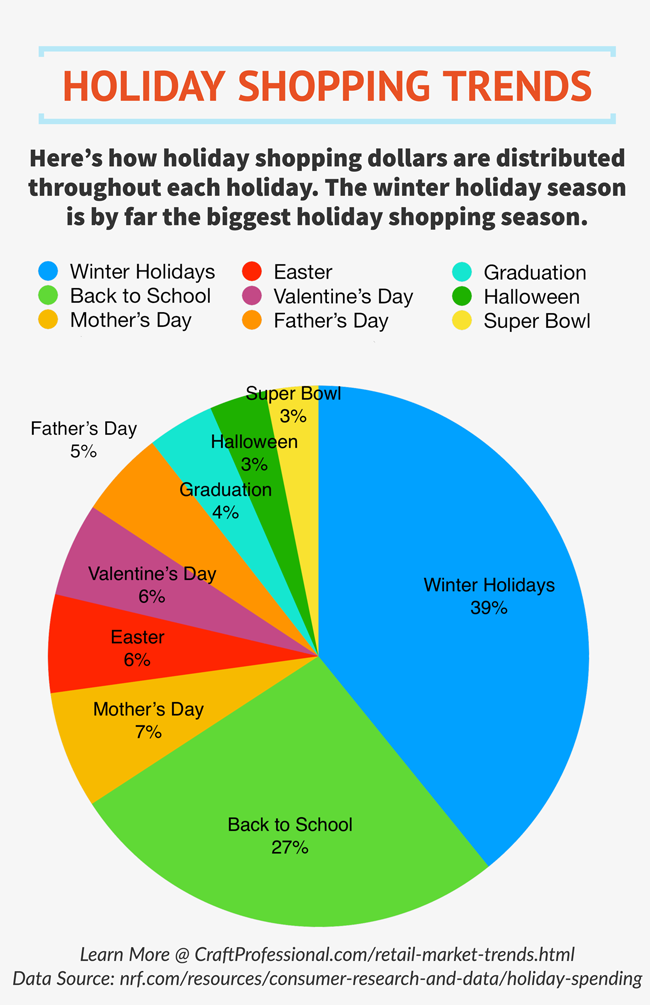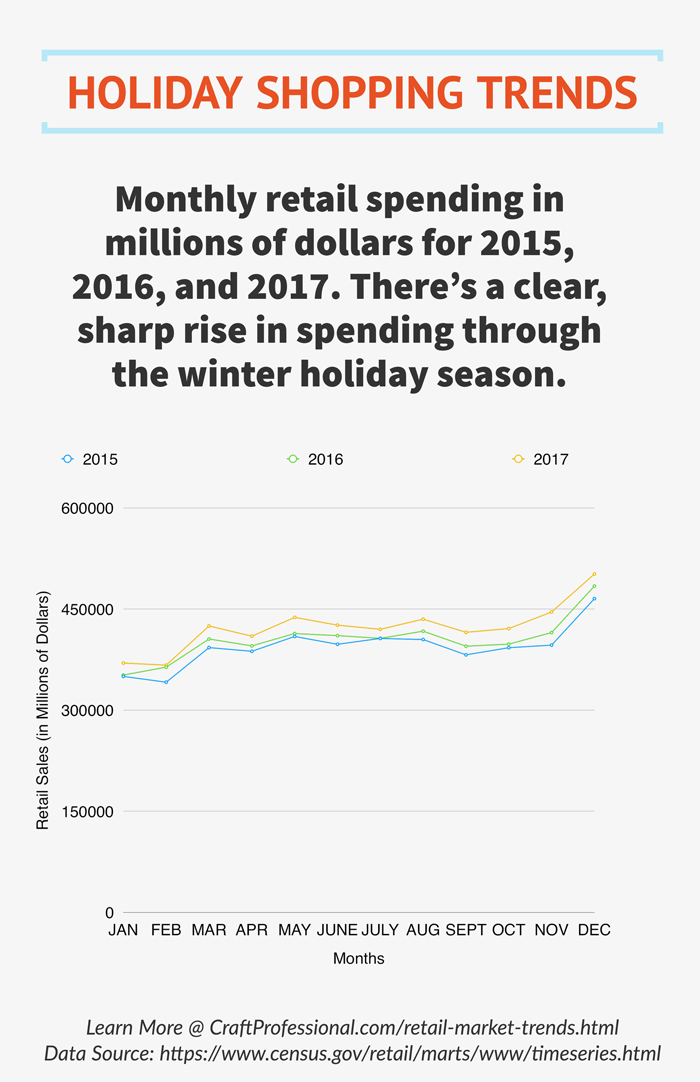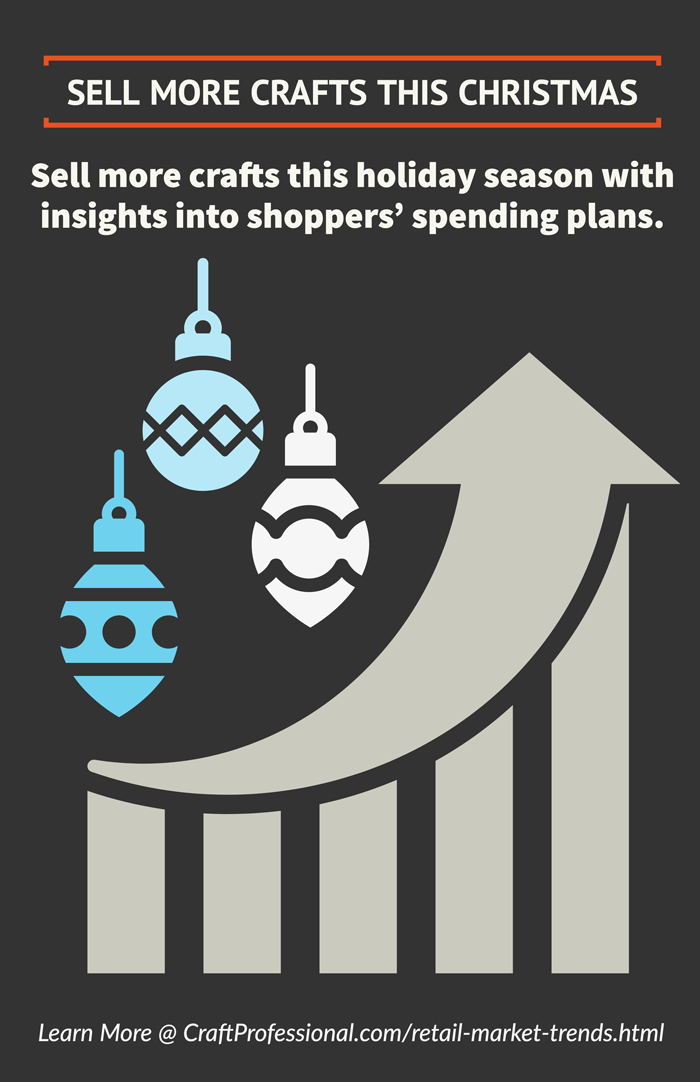Retail Market Trends - Christmas Holiday Shopping Data and Predictions for 2018
I've spent a week diving deep into retail market trends data with a specific focus on holiday shopping trends and predictions. Jumping into a pile of statistics isn't everyone's idea of fun, but it is immensely important to know you're making your business decisions based on evidence and not on random chance.
If you were looking for current holiday retail industry trends, check out my 2021 Christmas Shopping Trends report written specifically to help craft business owners sell more crafts in 2021.
In the midst of all the retail market trends data, I found interesting lessons you can use to boost your craft sales both in person and online this holiday season.

What are we talking about when we refer to the holiday shopping season?
In most of the holiday retail market trends surveys and data I've reviewed, the holiday shopping season is defined as retail shopping that occurs between the months of November and December. So, when I refer to the holiday season, or Christmas shopping season, or winter holiday season, I'm talking about the sales you make from November to December.
Data from the National Retail Federation shows there are strong sales opportunities beyond November and December. Specifically 20% of people begin holiday shopping in October.
There are also opportunities for making sales later than you might think. The week between Christmas and New Years Day (called Cyber Week II by some retail sales analysts) can present some good sales opportunities as well.
However, Christmas spending peaks through November and December. Most of the studies I've reviewed are focused on spending in those months, so that's the time frame we'll focus on.
Holiday sales are crucial to any retailer, including craft professionals.
The first lesson that's important to take in is that holiday sales in general, and winter holiday sales specifically, are extremely important to a retail business.
For your particular business, some holidays may be more important than others depending on the type of craft you sell. For example, the person who makes luxury artisan chocolates in a downtown shop, will be busier on Valentine's Day than the person who sells downloadable costume patterns in an Etsy shop. Of course, the pattern designer will expect to be extra busy in the weeks leading up to Halloween.
The National Retail Federation collects data for average spending during major American holidays and events.
Here's How Holiday Shopping Dollars are Distributed Throughout the Year
- 39% Winter Holidays
- 27% Back to School
- 7% Mother's Day
- 6% Easter
- 6% Valentine's Day
- 5% Father's Day
- 4% Graduation
- 3% Halloween
- 3% Superbowl
You can see in the chart below how important winter holiday sales are overall, but do keep the unique nature of your own business in mind as you check out the numbers.

Still more retail market trends data shows us that 74% of American retailers say that at least 20% of their annual sales occur during the holiday season, and 41% say that Black Friday is their most profitable day of the year.
In fact, retail spending increases dramatically in the holiday season, which is plenty of reason to do all you can to make the most of your sales in November and December.
Retail spending data from the US Census Bureau illustrates this point clearly.

What do retail market trends surveys say about when holiday shoppers are shopping?
If you're convinced the winter holiday season is an excellent time to make the most of your sales, the next thing to consider is when are holiday shoppers doing their shopping.
Big retailers have, in recent years, started to offer impressive deals before Black Friday. This development has prompted shoppers to start their shopping early.
If you plan to offer sales and coupon codes for your products throughout the holidays, consider starting those sales early. A fantastic promo with time taken to build excitement and anticipation can help you attract those early shoppers.
Because big retailers are pushing the beginning of this season earlier, if you wait until Black Friday to start your own holiday promos, you'll have missed a big part of the season.
What are the key holiday shopping dates retailers should be aware of?
- Black Friday - The day after Thanksgiving in the United States
This day has traditionally been the day brick and mortar shops hold huge sales, although it has, over the years, expanded to include deals at online shops. Black Friday was initially an American phenomenon, but it has become popular globally. In 2017, sales on Black Friday were 227% higher than average daily sales in October of the same year.
- Cyber Monday - The Monday after Black Friday
Cyber Monday started out as the day online shops held huge sales. It was the internet's answer to in-store Black Friday sales.
- Cyber Week I - The week starting on American Thanksgiving (the day before Black Friday).
Big holiday sales have begun to extend beyond the traditional Black Friday and Cyber Monday sales. Retailers often offer sale prices in the days around these two dates and see big sales throughout the week, not just on these two days. Cyber Week I acknowledges that the days around Black Friday and Cyber Monday also tend to be strong sales days for retailers.
- Green Monday - The 2nd Monday in December
This date typically falls a couple of weeks before Christmas. It's nearing the last date you can order something online and expect to receive it by the holidays. In store, sales on this day are fuelled by last minute shoppers.
- Cyber Week II - The week between Christmas and New Year’s Day
Those who remember Boxing Day sales will understand Cyber Week II. This week's sales are driven by shoppers looking for post-holiday bargains as well as people who received gift certificates.
Think of the holiday shopping season as a stretch between November and December, with some extra-strong opportunities for sales on the dates above.
Your marketing can target these dates, but do try to work to build interest over the whole season. Consider a few messages to tease upcoming promotions on your social media platforms, in your newsletter, and on your Etsy shop to help drive interest.
Don't forget about Cyber Week II.
Etsy's own data shows that sales remain surprisingly strong right through December and into January. So, don't step back from all of the holiday hustle too quickly. There are sales opportunities to be had, and there will be time to rest later.
How to Sell More Crafts This Christmas - Key Takeaways
- The winter holiday shopping season is focused in November and early December, but there are strong opportunities to sell to holiday shoppers both before and after these dates.
- Christmas holiday shopping presents excellent opportunities for craft professionals. For many retail businesses, this season is their more important and more profitable.
- Key holiday shopping days include: Black Friday, Cyber Monday, Cyber Week I, Green Monday, and Cyber Week II.
- But don't wait until Black Friday to start any planned sales build interest over time and consider offering an earlier promotion. Retailer's promotions are starting earlier, and shoppers are shopping earlier.
If I have convinced you about the important of the winter holiday shopping season, the next step is to decide how you're going to position your products and entice holiday shoppers.
Luckily, the dive into holiday shopping statistics doesn't stop here. I've also spent time assessing the data to get a feel for retail market trends that reflect what holiday shoppers are looking for in 2018.



New! Comments
Have your say about what you just read! Leave me a comment in the box below.